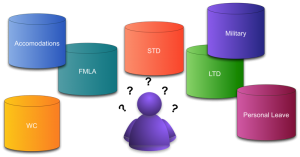How to Manage Employee Absences

 Authored by Steve Holden. Published in the Sacramento Business Journal July 2014.
Authored by Steve Holden. Published in the Sacramento Business Journal July 2014.
Employee absences are a major drain on an organization. The effect on productivity is obvious: No employee, no production. But the impact often goes beyond the loss of productivity. Morale issues may develop among the employees who are regular in attendance and who may bear an extra burden to cover for the missing employee.
Effective organizations put appropriate systems in place to manage employee absences and reduce the harm they cause. Good systems also serve to reduce exposure to employee claims based upon the many types of absence protected by law.
Protected time off
State and federal law have an enormous effect on how employers handle employee absences and address their impacts. The law sets forth many circumstances under which the employer must accept the employee’s absence and ensure that the employee is not discriminated or retaliated against for taking the absence.
The law also includes detailed rules on employee benefits that may relate to the absence. The types of leaves protected by law, which vary somewhat for employers of different sizes, include:
• Family and medical leave (50 or more employees)
• Pregnancy disability leave (five or more employees)
• Military leave (all employers)
• Military spouse leave (25 or more employees)
• Organ or bone marrow donor leave (15 or more employees)
• Civil air patrol leave (15 or more employees)
• Drug or alcohol rehabilitation leave (25 or more employees)
• Adult literacy program leave (25 or more employees)
• Parent/guardian of suspended student leave (all employers)
• School/day care activity leave (25 or more employees)
• Election official leave (all employers)
• Voting leave (all employers)
• Jury or witness duty leave (all employers)
• Crime victim leave (all employers)
• Victim of domestic violence, sexual assault or stalking leave (all employers)
• Volunteer firefighter/reserve peace officer/emergency rescue leave (all employers)
• Workers’ compensation leave (all employers)
• Disability accommodation leave (five or more employees)
Absence management systems
Effective systems for managing employee absences contain certain key elements. While the system may not fail entirely if an element is missing or defective, accounting for all of the key elements will greatly increase the effectiveness of the system.
* Policies and procedures. Thoughtful and clearly drafted policies and absence-reporting procedures are an essential first step. The policies should identify the employer’s expectations and educate employees on the negative effects of excessive absences. The procedures should guide managers through legal compliance.
* Train managers. Managers should be trained on their responsibilities related to employee attendance. Those responsibilities may include monitoring absences, recording and coding absences, and communication with employees. Managers also have a significant impact on workplace culture, and the organizations with the fewest absence-related problems are organizations that have created positive working cultures. Managers need not know the complex details of all the protected leaves, but they must be able to recognize when an absence might be protected and what to do in such cases.
* Carefully analyze each absence. While it is unrealistic to expect each manager to know all the details of leave law, someone with extensive expertise must be involved in analyzing any absence or leave request that may fall under legal protection. That may be a senior human resource manager within the organization or it may be outside professional help. Failure to fully analyze the absence often leads to unintentional liability.
* Carefully document the absence or leave. An effective system will include easy, regular and accurate recording of an employee’s absences. Even routine absences should be carefully and accurately recorded within the system. Absences that are legally protected must be carefully documented. The documentation should meet all of the legal requirements for employee notice, but it should also be prepared to ensure the employee completely understands the obligations and expectations surrounding the leave. The documentation should create a clear and concise chronology of the employer’s compliance. Most importantly, the system should ensure that the communication and proper documentation continue throughout the leave. Too often a leave is documented at its beginning, but documentation and employee communication drops off as the leave continues. Too often there is virtually no communication and documentation at the leave’s termination. This invites misunderstandings and employee claims that are difficult to defend.
* Return-to-work interviews. In some instances, the return-to-work interview and information gathered through it will be legally required to ensure that the employee can be returned to work without risk and within the rules of the particular leave. In other instances, the interview may have less legal impact but remains essential for gathering information on why absences are occurring. Such information can lead to structural and policy changes that reduce total absences and improve productivity.
* Other possible elements. Effective systems also may include a process for checking the attendance history of applicants during the hiring process. While this may block the hiring of individuals with poor histories, there are legal restrictions on what type of attendance information can be used lawfully in hiring decisions. Effective systems also may include initiatives and incentives to encourage good attendance. However, care must be taken in crafting the incentives to avoid discrimination against employees with protected absences.
Employee absences cannot be avoided. But, with an effective system in place to address employee attendance, employers can significantly improve productivity and employee morale.
